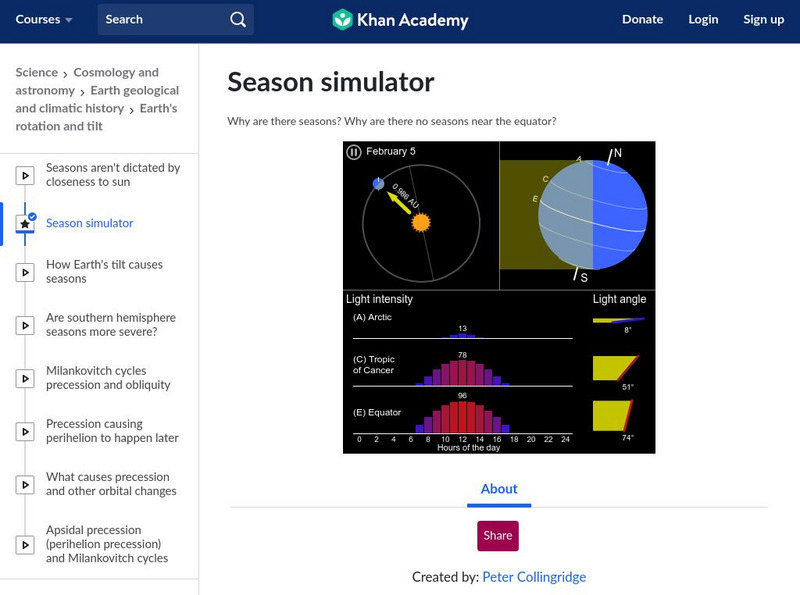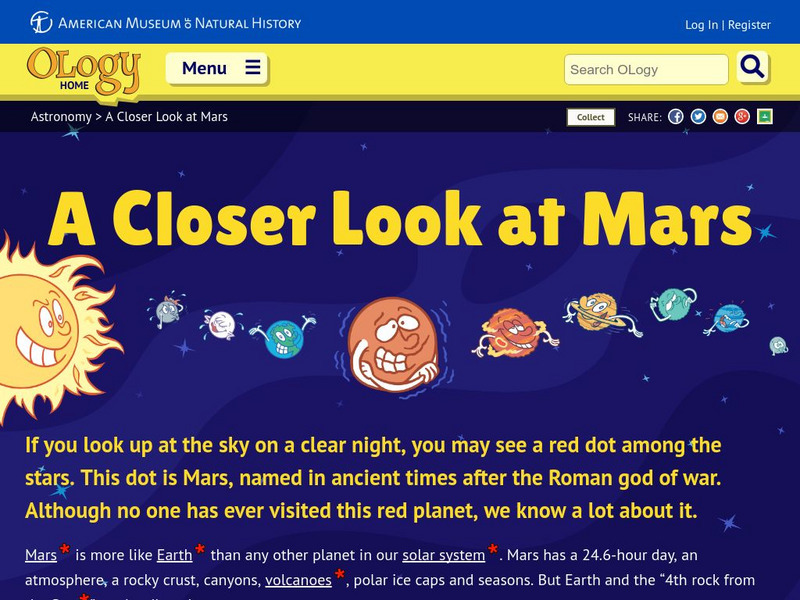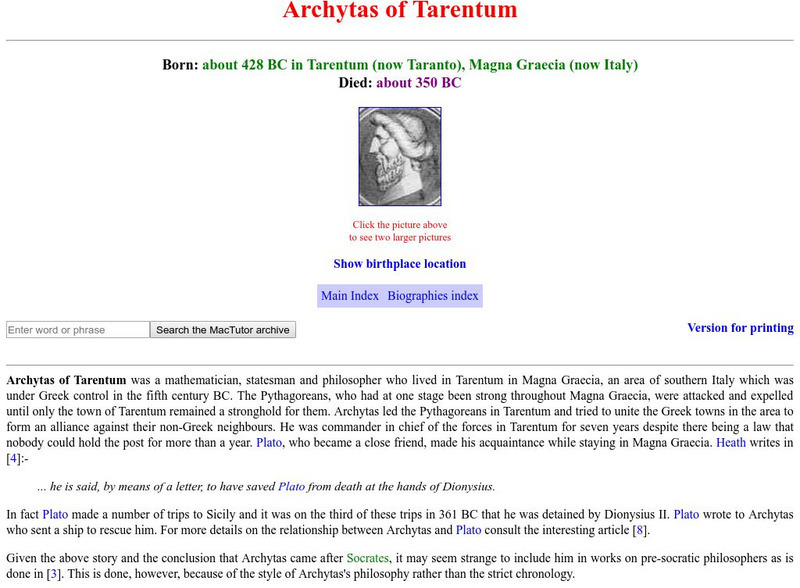Hi, what do you want to do?
Khan Academy
Khan Academy: Cosmology and Astronomy: Season Simulator
This season simulator takes Earth through an entire year cycle allowing the viewer to observe the tilt of the Earth and the intensity of the sunlight.
American Museum of Natural History
American Museum of Natural History: Ology: In Pictures: Journey to the Stars
Two astrophysicists present images of stellar phenomena in this resource and explain why stars are so important to the existence of life on Earth.
American Museum of Natural History
American Museum of Natural History: O Logy: Stuff to Do: Stargazing
Get started on the road to becoming an expert stargazer by following these recommendations for identifying stars, planets, and constellations. Includes an example of a journal that can be used as a record of your investigations.
Smithsonian Institution
National Museum of American History: The Remarkable Star Map of Simeon De Witt
Simeon de Witt created his star map in 1780 after studying European star maps and the skies. His is the 'oldest surviving Anglo-American star map.' Read about the history of star maps, a biography of Simeon de Witt, and the influence his...
PBS
Pbs: A Science Odyssey
Website for the PBS series "A Science Odyssey." Numerous opportunities to explore the people and discoveries of science.
Chicago History Museum
Encyclopedia of Chicago: Adler Planetarium
Examine the history of famous Chicago landmark, the Adler Planetarium and Astronomy Museum.
NASA
Nasa: Astronomy Picture of the Day: Hypatia
Learn more about Hypatia when you check out this resource. This site features a picture and a brief synopsis of this famous scientist.
Ducksters
Ducksters: Astronomy for Kids: Constellations
Kids learn about the constellations in the science of astronomy. These stars that form patterns when viewed from the Earth have been studied since ancient times.
Ducksters
Ducksters: Astronomy for Kids: Space Exploration Timeline
Kids learn about the timeline of the history of space exploration including early astronomy, astronauts, spacecraft, planets, and the Moon.
Canadian Museum of History
Canadian Museum of History: Maya Civilization
Lots of information about many facets of the Maya civilization. Covers the history, people, geography, languages, cities, society, cosmology, the calendar, and lots more. Includes a glossary and a timeline.
Other
Lund University Libraries: Directory of Open Access Journals
Open access journals are offered in all scholarly and scientific disciplines such as Biology and Life Sciences, History and Archaeology, and Physics and Astronomy. Site offers a search for new titles as well as archived journals....
Clark University
Clark University: Dave's Short Trig Course: Applications of Trigonometry
This Clark University site gives a brief historical perspective into how trigonometry is used in astronomy, geography, engineering, physics, and mathematics.
Christian Science Monitor
Christian Science Monitor: The Map of the Millennium
This article from the Christian Science Monitor explores the impact of key astronomical discoveries of the past millennium on science and religion.
Other
The Royal Observatory at Greenwich: Homepage
This site from The Royal Observatory at Greenwich is a very historically important astronomical observatory. The site has a combination of information about astronomy, longitude and time. Information written in highly accessible...
Harvard University
Harvard Smithsonian Center for Astrophysics: 1.2 Meter Millimeter Wave Telescope
Describes the collection of 1.2m millimeter wavelength radio telescopes that are operated by the Millimeter Wavelength Group at Harvard Smithsonian. It details some history of radio astronomy and of the telescope itself, gives great...
The History Cat
The History Cat: Mayan Achievements
Discusses the Maya system of astronomy and their calendar.
Stephen Byrne
History for Kids: Ancient Chinese Science
History for Kids overview on the science and innovations of ancient China. Students learn about the significant impact China made on the world with contributions in the fields of astronomy, chemistry, physics, meteorology and seismology.
Internet History Sourcebooks Project
Fordham University: Modern History Sourcebook: Principles of Natural Philosophy
This site from Fordham University is an exerpt from Newton's famous "Principia."
American Museum of Natural History
American Museum of Natural History: O Logy: A Closer Look at Mars
If you look up at the sky on a clear night, you may see a red dot among the stars. This dot is Mars, named in ancient times after the Roman god of war. Although no one has ever visited this red planet, we know a lot about it. This site...
American Museum of Natural History
American Museum of Natural History: Ology: What Do You Know About Stars?
Test your knowledge with this ten-question quiz on stars. Focusing on stars in the Milky Way galaxy, questions range from the life cycle of a star to the number of stars in our galaxy.
American Museum of Natural History
American Museum of Natural History: O Logy: Stuff to Do: Space Travel Guide
What makes science fiction so exciting? Read some examples of the genre and then create your own science fiction story about space travel. Use the supplied "travel guide" to generate ideas and structure your plot.
American Museum of Natural History
American Museum of Natural History: O Logy: Stuff to Do: Moon Watch Flip Book
Hands-on activity shows you how to make a flip book of the moon using close observation skills and simple materials. Includes animation that lets you view the moon in action through its different phases, worksheets, and illustrated...
University of St. Andrews (UK)
University of St. Andrews: Archytas of Tarentum
Claiming that "mathematics was composed of four branches, namely geometry, arithmetic, astronomy, and music", Archytas made an impact on Plato and other mathematicians.
American Museum of Natural History
American Museum of Natural History: O Logy: How Did the Universe Begin?
Bite-size introduction to two scientists-Hubble and Lemaitre-who played key roles in formulating the theory of the origin of the universe known as the big bang. Includes an interactive timeline on which you can plot out the approximate...



















